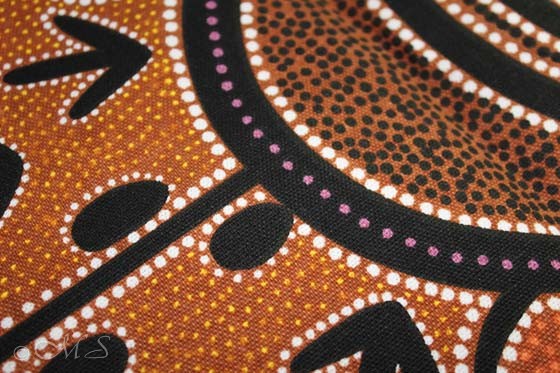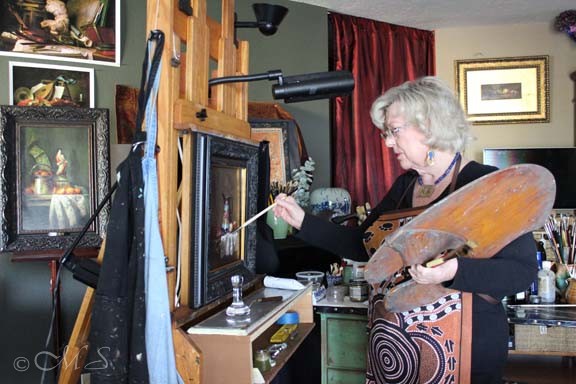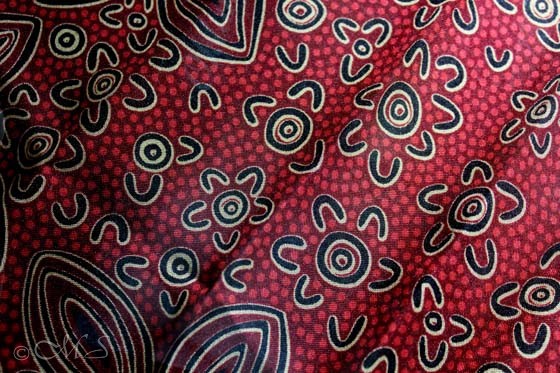This past summer, Dave and I had the great pleasure of hosting a studio visit that resulted in some interesting connections and enlightenments. This particular group of collectors were visiting the Northwest from Australia. Having visited this area in the past, they fell in love with Oregon and just happened to find my oil paintings at Gallery 903 in the Pearl District in Portland. So on this visit they arranged to come to my studio where we entertained and were entertained by them. It was a delightful day of viewing art, talking about paint making, painting techniques, and discoveries of many other personal similarities.


Dot Art: A Record of the Aboriginal People
Our visitors very graciously brought two gifts from Australia and presented them to me at the end of the day. This apron (above), which I happily wear now while painting, is an example of Aboriginal dot art. If you look closely, you can see the pattern of dots all throughout the patterns of various colors and shapes. This is a common artform originating in the desert of Australia using sand, charcoal, paints made from colorful dirt, and other natural substances painting the shapes, ceremonial stories, and images right in the sand. These dots represent the spinifix grasses which dot the desert bush and has profound meaning to the Aboriginal people of the area. This culture does not have a written language so this is their way of passing down stories of ceremonies and history to the new generations.

Maureen Hudson Nampajimpa, the Aboriginal artist who created this scarf which was the second gift, is from the Mt. Allan region where she grew up in a traditional way living in the bush where ceremonies were very important. Painting was only done on the body or the ground. Maureen started painting in the mid 80s and says of her art, “My main stories are my father’s stories of fire dreaming, Napa-water dreaming, lightening dreaming. And my mother’s side as well. Women’s ceremonies. My skin name is Nampajimpa and on my mother’s and uncle’s side, Numeratumera.”

Dot Art and the Moriage Oil Painting Technique
As you have probably guessed by now, I could not resist the comparison of Aboriginal dot art to the moriage decoration on the Nippon vase in my oil painting shown here and on many other objects previously used in paintings over the years. The dot art paintings contain special meanings that are hidden from new owners of the art and viewers gain insight over time by gazing into the paintings. The indigenous artists are prideful that their art is purchased and allows them a validation that it has value.
I plan on gazing into the dot art of this culture for many years to come with fond memories of our day with our friends from Australia.

Hi Margret,
What a fascinating post about the beautiful Aboriginal art of Australia. Thanks for sharing your visit from the folks from “down under”.
Say hi to Dave for us and have a wonderful Thanksgiving.
Sincerely,
Gary, and Michele, too.
Hi Gary and Michele too! Glad you liked my story about the Aboriginal dot art and our Australian visitors. As you can imagine it was a delightful day.
Have a nice Hawaiian Thanksgiving.
Warm Wishes,
Margret
Margret, I like checking in to see what you’re up to because you are always ahead of the curve. If you don’t mind I’d like to add some supporting ideas to expand on the connections between Aboriginal dots and the Moriage and your own placement of discreet points of light. The idea of dots interests me because they show up almost everywhere in the primitive world right through modern printing, Pop Art, digital art and fractal art. Some people just see in pixelated forms or express themselves in dots (and dashes) more naturally. You and I tend to be blenders but there is no escape from the dot. I am certain that you have been greatly inspired by Vermeer’s Milkmaid. I also grew up with Seurat’s Sunday Afternoon on the Grand Jatte, having seen it almost every year of the past 50. Seurat called his pointillist technique “chromo-luminarism.”
I think I’ll pause here because this could get lengthy. I’ll connect more dots later.
Hi Sander, It’s always nice to hear from you and to read your interesting insights into painting techniques that we both use and admire. Since learning about the Aboriginal dot art, I have noticed the dot is frequently used by many artists in many cultures, along borders, edges, and such, just as you suggest. Often a raised repeating dot or rounded shape is used on furniture, picture frames, wood, or plaster in decorations of all kinds.
I particularly love to use the dot shape on porcelain or glass surfaces on objects in my paintings because of the textural quality. The raised impasto itself creates a shadow shape when light hits the surface of the painting, hence, a more intense 3-d effect naturally occurs.
Interestingly, I have never been fond of Seurat’s pointillist style. On the other hand, the dots of lead-tin yellow that Vermeer used in his oil paintings as highlights on lips or other objects create brilliant tiny dots of light. I never tire of looking at those little strokes of genius.
Warm Regards, Margret
Margret it is so interesting that we see things with such similar sensitivities. I smiled when you mentioned Seurat because I also never bought into the pointillist story except as an important footnote in western art history. But I do look at this huge inescapable painting that is a cornerstone of the Chicago Art Institute. Early art girlfriends admired it so I grew cautious about those dots. The entire painting is bordered by a decorative band of dots. This has become a very popular effect in some illustration, commercial work and “fine art.” And it leads me to other dots.
Sander, You wisely heeded your inner voices by taking a liking to the Seurat in your early years, but remained circumspect. While visiting Chicago in the late 70s, I saw the Sunday Afternoon painting, and my only real memory of it is that it is huge, though I do not remember the dotted border. With the exception of just a few, the Impressionist period has never interested me. I prefer the rich dramatic high-contrast of chiaroscuro. When I first began my art studies, my instructor taught a limited palette, old master technique. Then and there I fell in love. I subsequently tried all kinds of other styles and mediums and finally came full circle back to chiaroscuro where my interests have remained for many years now. Always fun to connect with you.
Cant wait to see this new art form in person. New to me that is. What a wonderful gift, it will live on and on in your paintings. You never cease to amaze me in your ventures as a very well know artist. You know who you are and where you are going. I am just tagging alone for the ride and remember our days in grade school of doing the same thing. Its been a great ride so far! Love you my life long friend.